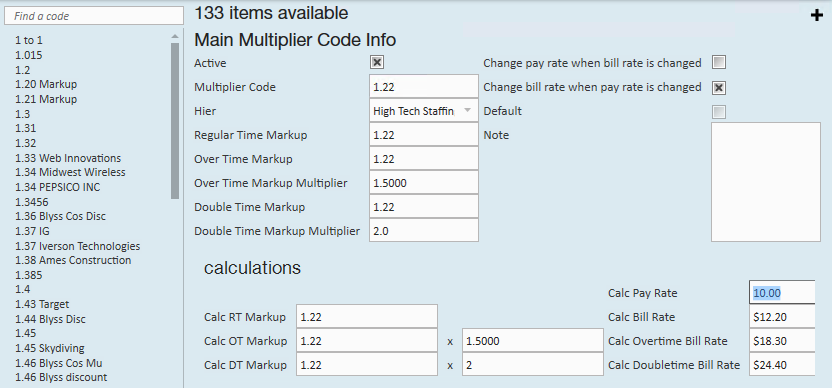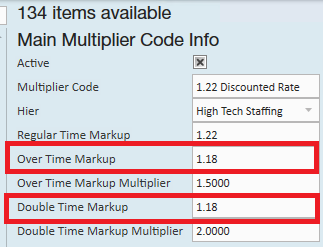What are Multiplier Codes?
Depending on your contractual agreements with your clients you may want to use the multiplier code options within Enterprise™. These will be extremely helpful if your billing agreements with clients are based on a multiplier (mark-up).
Multiplier codes are also helpful for clients who have discounted overtime or double time markups. For instance, all of your business is at a 36% markup but your client understands OT and DT hours are not as expensive. In this case, you would apply a discounted markup of 33% on OT and DT hours.
In Enterprise, you have the ability to apply numerous multiplier codes. This is helpful for our example of discounted markups on OT and DT hours. This is also helpful for applying different multiplier codes based on the type of job (clerical vs. industrial) or if you use a different multiplier code for payrolled employees.
Before a multiplier code can be setup on a customer record it must be added to the list. This can be done from the navigation tree by going to options/administration/multiplier code.
*Note* If your agreements with customers stipulate a dollar amount and not a mark-up, consider setting up rate sheets. Please see the related article "How to Create and Utilize Rate Sheets" for help with this.
Creating Multiplier Codes:
Creating (and editing) multiplier codes is part of the administration area. From the navigation tree go to all options/administration/multiplier code.
*Note*Only users that have been given access to administration functionality (administration security role) will have this option available in the menu.
*Note* Setting up multiplier codes within administration, you are creating the drop-down list which will be used on the customer, order, and/or assignment records.
Check out the following video for a walk through on making multiplier codes:
To add a new code click the + icon in the upper right corner of the form.
To avoid duplicates, it is highly recommended to try to look up (find a code) the desired multiplier code before adding.

When naming the multiplier code, if you are going to use this code for several clients, it is recommended you name it the markup amount (1.22 or 22%).
If the multiplier code will be used specifically for a certain client you may want to name the code so it is easily identified for that client (ABC 1.22).
After naming the multiplier code indicate at what hierarchy level you would like the code accessible. System wide, entity, class or branch specific.
When entering the markups and multipliers it's easiest to think of starting with the pay rate to get to the bill rate, over time rate, and double time rate.
In our example:

The bill rate will be: pay rate x regular time markup
The over time rate will be: pay rate x over time markup x over time markup multiplier The double time rate will be: pay rate x double time markup x double time markup multiplier
There is a sample calculator in the lower right to verify the numbers you've entered are correct:

When using the multiplier code on an order in Enterprise, based on what is setup in the administration area, your bill rate may auto-populate based on what is entered into the pay rate field and vice-versa.

If both options are selected, the rates will be "locked down".
*Note* These defaults will carry down to the assignment from the order. As long as the multiplier is in use, if both options are selected, the defaulted pay or bill rate will not be able to be overridden.
Discounted OT Rates:
Clients may become very savvy about OT rates. While we must pay OT at time and 1/2 , we can bill OT at whatever we want. You may agree with a customer to bill regular hours at one multiplier but bill OT at a lesser amount. This can be accomplished when setting up the multiplier code:

*Note* When setting up discounted OT multiplier codes, you may want to name that code so it is more easily identifiable when viewing the list.